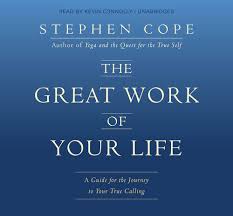Stephen Cope is an American author and psychotherapist who writes and teaches about the relationship between contemporary psychology and the Eastern contemplative traditions. He holds degrees from Amherst College and Boston College.
He was a Senior Scholar-in-Residence at the Kripalu Center for Yoga and Health in Lenox, Massachusetts and was a leader in Kripalu’s evolution from ashram to the largest residential yoga center in the world. His best-selling books include Yoga and the Quest for the True Self and The Wisdom of Yoga.
In this book, Cope describes the process of unlocking the unique possibility harbored within every human soul. The secret, he asserts, can be found in the pages of a two-thousand-year-old spiritual classic called the Bhagavad Gita, an ancient allegory about the path to dharma, told through a timeless dialogue between the fabled archer, Arjuna, and his divine mentor, Krishna.
I enjoyed this book tremendously because it gave me a much better understanding of the Bhagavad Gita. The author centers the book on this ancient Hindu text, and the concept of dharma, one’s true calling in life. He uses the story and characters in the Gita to frame different biographical chapters about famous people, among them Jane Goodall, Walt Whitman, Susan B. Anthony, Harriet Tubman and Mahatma Ghandi, who have followed their dharma and serve as perfect examples of how to find one’s own and why it is important to do so. Cope includes in this book everyday stories about following the path to dharma, his own personal story and how this all affected his own life and that of his friends.
The Bhagavad Gita is a wonderful teaching on the problems of doing and a guide how we can authentically express who we really are. Cope states the Bhagavad Gita was written precisely to show us how to make the world of action an arena for spiritual development.
Chapter by chapter he explains how we know to what actions we are called in this life. He addresses the issue of doubt, certitude, and fear of closing certain doors when one pursues his/her dharma. He tells us, that the only way to get to certitude is to look more and more deeply into our doubt – “to shine light into the dark corner of our self-division”.
He describes the central pillar of the path of action – to look at your dharma, to do it full out, to let go of the fruits and to turn it over to God.
He quotes Thomas Merton who said, that every man has a vocation to be someone, but he must understand clearly that in order to fulfill this vocation he can only be one person, himself.
Numerous times the author points out, “If you bring forward what is within you it will save you, but if you do not, it will destroy you”. He warns us of leading a life founded on self-betrayal, which we recognize if we feel a growing emptiness inside. Lack of interest, lack of enthusiasm and a lack of soul-connection to work are typical warning signs. He also explains that in the end no one really cares what we are doing with out life so we have to make sure that life is working for us.
At the same token he admits that dharma always involves at some point a leap off a cliff in the dark and that failure at one point is part of all great dharma stories. Careful attunement to dharma will demand that we reinvent ourselves periodically throughout life.
In his words, “Our actions in expression of our dharma – my actions, your actions, everyone’s actions – are infinitely important. They connect us to the soul of the world. They create the world. Small as they may appear, they have the power to uphold the essential inner order of the world.”
